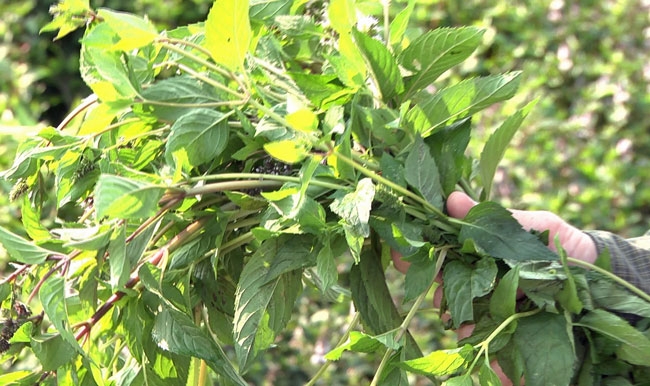
Many people enjoy the cool and refreshing peppermint flavor without knowing there are ingenious farmers and agricultural researchers working year-round to produce the naturally spicy bite of this holiday icon. Candy canes get their distinctive taste from the oil secreted under the leaves of Mentha × piperita, the bright green herbaceous perennial herb known as peppermint.
Peppermint, a cross between spearmint and wintermint, is America’s most popular mint flavor. Peppermint oil is an important ingredient not just in candy; it is used in toothpaste, mouthwash, gum, pharmaceuticals and beauty products.
The majority of U.S. peppermint is cultivated in the Pacific Northwest, where summer days are warm and long and nights are cool, minimizing the presence of a chemical that imparts a bitter taste in the mint oil. In far northern California – near the University of California’s Intermountain Research and Extension Center in Siskiyou County, plus in Lassen County and in the Fall River Valley of Shasta County – the soil and climate are equally hospitable to mint production.
UC researchers have experimented with mint for more than 50 years, said Rob Wilson, UC Cooperative Extension advisor and director of the Intermountain REC. But it wasn’t until the mid-1990s that interest in commercially producing California peppermint took off. The 2010 peppermint acreage in northeast California was more than 3,500 acres and valued at about $7 million.
“Farmers are excited to have a new cropping choice like mint,” Wilson said, “especially given the fact that we have fewer choices than most areas of California because of our short growing season. Mint has given our farmers a new crop to add to their rotations.”
California peppermint oil producers have stiff competition. A significant quantity of peppermint oil is now produced in China and India. But U.S. growers see the opportunity to set their product apart by applying their agricultural skill to producing exceptionally high quality oil. To do so, the growers rely on research to inform their decisions on irrigation, fertilization and pest control. Extensive work on ideal mint management has been conducted in the Pacific Northwest, but there is a need for additional research to study mint production and economic viability under California conditions.
Peppermint is grown in a fashion similar to other field crops common in the intermountain region and can be harvested with some of the same equipment used for alfalfa and forages, Wilson said. Farmers plant certified verticillium wilt-free rootstock in the fall, and the peppermint stand produces a crop for about five years.
When mint has reached maturity, farmers swath the field like alfalfa and leave the plants to dry a few days before raking them into windrows. Using a forage harvester, the peppermint crop is chopped into small pieces and blown into tubs. At the distillery, steam is forced through the tubs to extract the oil.
“In harvest season, there’s a fragrant aroma of peppermint in the air,” Wilson said. “Even driving by a still along the highway, you immediately notice the smell.”
Peppermint begins bearing a crop the first year after the fall planting, producing 40 to 90 pounds of mint oil per acre. In subsequent years, the crop produces 60 to 120 pounds of oil per acre.
Wilson and Dan Marcum, UCCE advisor in Shasta and Lassen counties, developed a cost study for establishing and producing peppermint oil in the intermountain region. The UC study notes the importance of determining a market channel for the oil before the mint is planted. Annual contracts for the oils are generally negotiated in the winter for the following season at a fixed number of pounds at a set price. It is risky to grow the crop without a prearranged contract because on the spot market growers are competing with imported mint oil, which can be produced in areas where lower wages and limited regulations cut the production cost.
A major risk associated with peppermint farming, the study reported, is producing oil of poor quality, for which there is little or no demand. For example, weeds harvested with the mint lower the quality of oil. Pigweed and other broadleaf weeds contaminate the peppermint oil with a weedy flavor note. Plant stress caused by inadequate water or nitrogen or by insect damage can also reduce oil quality.
IREC has more than five acres of peppermint and a small peppermint still for studying production and evaluating the quality of oil. Wilson, along Intermountain REC superintendent Don Kirby, is using this acreage to compare irrigation, fertilization and harvest management strategies in order to maximize peppermint oil yield and oil quality under local soil and climatic conditions.
The IREC peppermint acreage is also used to study insect management. Among the pests that can reduce peppermint oil quality are spider mites and a recently introduced insect pest, mint root borer. These pests prompt significant pesticide use. Given the highly sensitive watersheds and environment of the intermountain area, wide usage of pesticides is considered problematic. Propargite and chlorpyrifos, the most commonly used pesticides for spider mite and mint root borer control, are under regulatory scrutiny.
In 2010, with funding from a California Department of Food and Agriculture Specialty Crop Block Grant, Larry Godfrey, UC Cooperative Extension specialist in the Department of Entomology at UC Davis, and Kris Tollerup, UC Davis post doctoral researcher, along with Marcum and Wilson, began investigating mint yield and quality response to spider mite infestation, spider mite management methods in mint, and reduced-risk insecticides for mint root borer management. In addition, a study is under way to determine if sex pheromone mating disruption is a plausible tactic against mint root borer, and whether adjusting the timing of the insecticide improve mint root borer control. These research projects will continue in 2013.
In the two-minute video below, Wilson explains how UC researchers use a mini peppermint oil still.